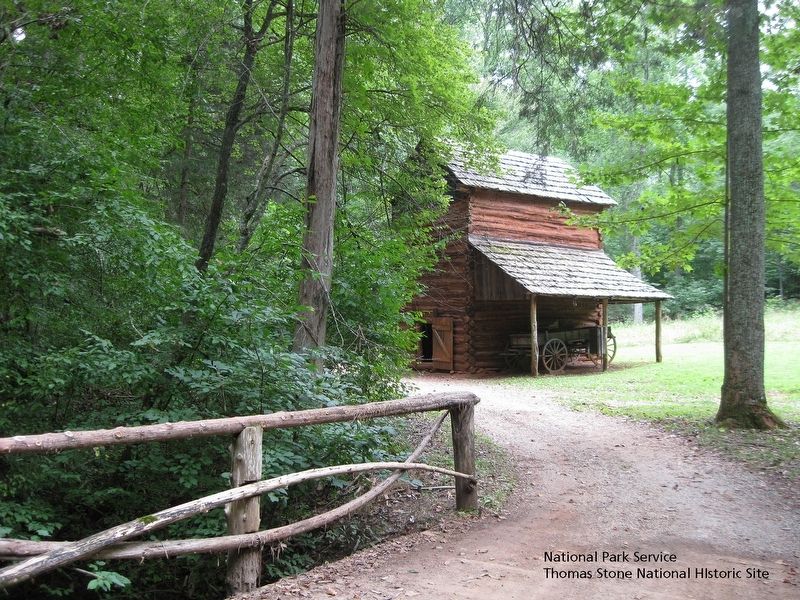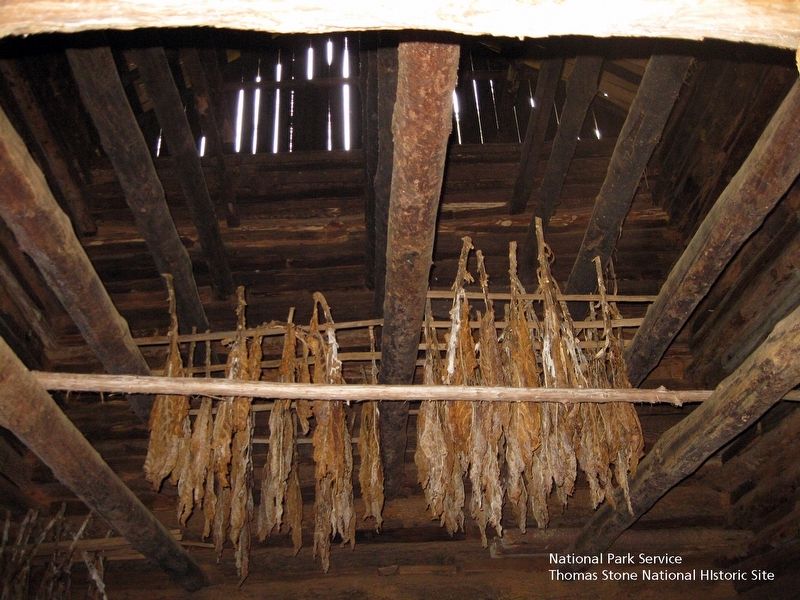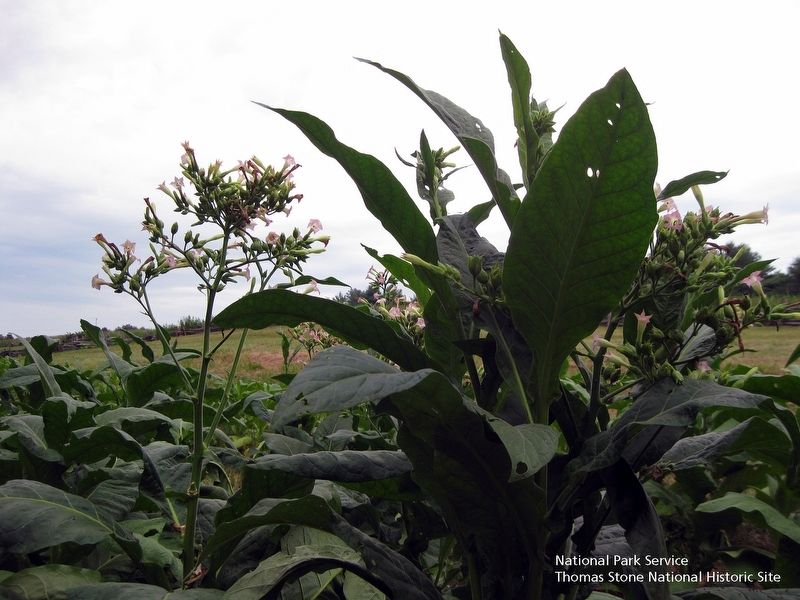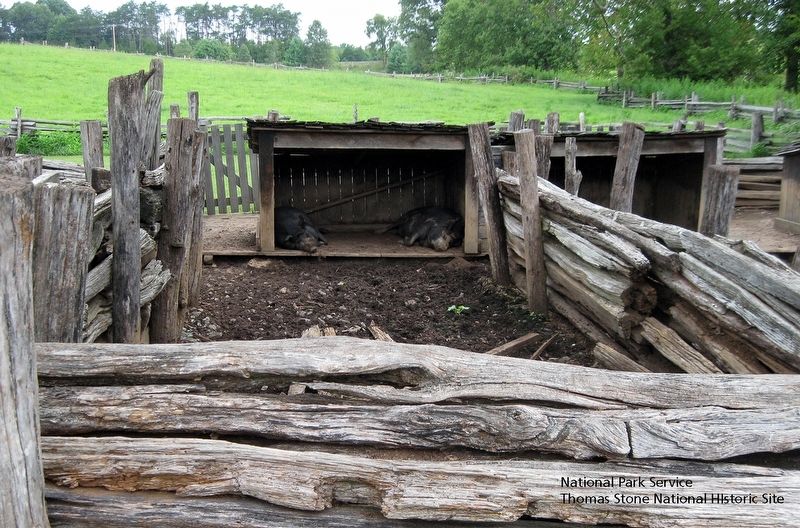Hardy in Franklin County, Virginia — The American South (Mid-Atlantic)
How Tobacco Farms Used Slavery
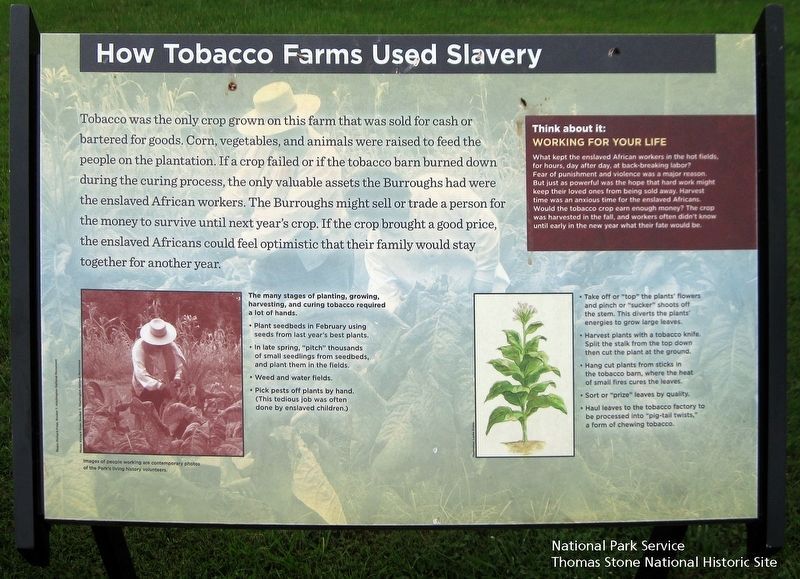
National Park Service, Thomas Stone National Historic Site, August 18, 2018
1. How Tobacco Farms Used Slavery Marker
Viewing marker from the north. Black & white background image shows people working in a tobacco field. An inset black & white image also shows workers in a tobacco field. A color inset image shows a flowering tobacco plant.
The many stages of planting, growing, harvesting, and curing tobacco required a lot of hands.
• Plant seedbeds in February using seeds from last year's best plants.
• In late spring, "pitch" thousands of small seedlings from seedbeds, and plant them in the fields.
• Weed and water the plants.
• Pick pests off plants by hand. (This tedious job was often done by enslaved children.)
• Take off or "top" the plants' flowers and pinch or "sucker" shoots off the stem. This diverts the plants' energies to grow large leaves.
• Harvest plants with a tobacco knife. Split the stalk from the top down then cut the plant at the ground.
• Hang plants from sticks in the tobacco barn, where the heat of small fires cures the leaves.
• Sort or "prize" leaves by quality.
• Haul leaves to the tobacco factory to be processed into "pig-tail twists," a form of chewing tobacco.
(sidebar)
Think about it:
Working For Your Life
What kept the enslaved African workers in the hot fields, for hours, day after day, at back-breaking labor? Fear of punishment and violence was a major reason. But just as powerful was the hope that hard work might keep their loved ones from being sold away. Harvest time was an anxious time for the enslaved Africans. Would the tobacco crop earn enough money? The crop was harvested in the fall, and the workers often didn't know until early spring in the new year what their fate would be.
(caption)
Images of people working are contemporary photos of the Park's living history volunteers.
Erected by Booker T. Washington National Monument, National Park Service.
Topics. This historical marker is listed in these topic lists: African Americans • Agriculture.
Location. 37° 7.165′ N, 79° 43.877′ W. Marker is in Hardy, Virginia, in Franklin County. Marker can be reached from Booker T Washington Highway (Virginia Route 122) 0.2 miles east of Lost Mountain Road (Virginia Route 636) when traveling east. Marker is found behind

National Park Service, Thomas Stone National Historic Site, August 18, 2018
2. How Tobacco Farms Used Slavery Marker
Viewing marker from the north. Black & white background image shows people working in a tobacco field. An inset black & white image also shows workers in a tobacco field. A color inset image shows a flowering tobacco plant.
Other nearby markers. At least 8 other markers are within 4 miles of this marker, measured as the crow flies. Freed Here, At Last (here, next to this marker); Slavery on the Plantation (within shouting distance of this marker); Booker T. Washington National Monument (within shouting distance of this marker); Booker T. Washington's Birthplace (within shouting distance of this marker); Booker T. Washington Birthplace (about 700 feet away, measured in a direct line); Jack-O-Lantern Branch Trail (approx. ¼ mile away); I think that I owe a great deal of my present strength and ability to work to my love of... (approx. 0.7 miles away); Taylor’s Store (approx. 3.4 miles away). Touch for a list and map of all markers in Hardy.
Also see . . .
1. Booker T. Washington National Monument, National Park Service. (Submitted on August 17, 2019.)
2. Dr. Booker Taliaferro Washington, Tuskegee University. (Submitted on August 17, 2019.)
3. Booker T. Washington National Monument, National Register of Historic Places. (Submitted on August 17, 2019.)
Credits. This page was last revised on August 19, 2019. It was originally submitted on August 17, 2019. This page has been viewed 318 times since then and 24 times this year. Photos: 1, 2, 3, 4, 5, 6. submitted on August 17, 2019. • Bernard Fisher was the editor who published this page.
